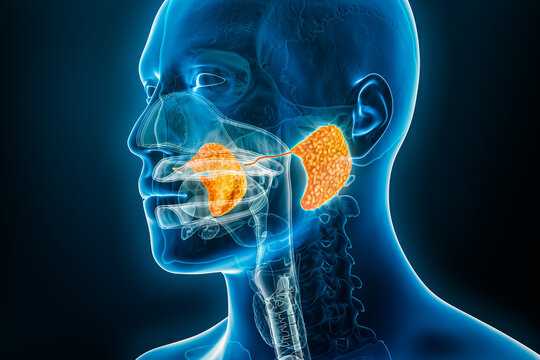Parotid Gland

Dr. Ranjit Kumar Padhiari
Head & Neck Cancer Specialist
Parotid Gland

Salivary glands are responsible for producing and secreting saliva, which plays a crucial role in digestion, lubricating the mouth, and maintaining oral health. One of the three primary salivary glands in the human body is the Parotid gland. The parotid gland is the largest of these salivary glands and is located near the ear, extending down to the jawline on both sides of the face.
Parotid cancer, also known as parotid gland cancer, is a relatively rare form of cancer that originates in the parotid gland. Parotid cancer can be challenging due to its location and the complex facial structures surrounding the parotid gland.
TYPES OF PAROTID CANCER
Parotid cancer can encompass several histological subtypes, each with unique characteristics:
- Mucoepidermoid Carcinoma: This is the most common type of parotid cancer. It consists of a mixture of muco-secreting cells and epidermoid (squamous) cells. Tumors may vary in aggressiveness.
- Adenoid Cystic Carcinoma: Known for its slow growth, adenoid cystic carcinoma can be locally aggressive, and it tends to invade nerves, making complete surgical removal challenging.
- Acinic Cell Carcinoma: Acinic cell carcinoma is characterized by cells that resemble serous acinar cells. It often has a more favorable prognosis compared to some other subtypes.
- Salivary Duct Carcinoma: Salivary duct carcinoma is a high-grade malignancy often associated with facial nerve involvement. It tends to be aggressive and may spread rapidly.
- Adenocarcinoma: Adenocarcinomas are a group of cancers originating in glandular cells. Their behavior and aggressiveness can vary.
Causes and Risk Factors:
The exact causes of parotid cancer are not well understood. However, there are some risk factors that have been associated with an increased likelihood of developing parotid cancer. These risk factors may include:
- Exposure to ionizing radiation, such as previous radiation therapy to the head or neck.
- A family history of salivary gland tumors or a personal history of salivary gland tumors.
- Certain genetic conditions, like Cowden syndrome or familial adenomatous polyposis (FAP), which can raise the risk of parotid cancer.
Symptoms:
Parotid cancer may present with a variety of symptoms, including:
- A Painless Lump or Swelling: Most often near the ear or jaw area, which is the most common initial sign.
- Facial Weakness or Paralysis: Especially if the cancer affects the facial nerve.
- Difficulty Opening the Mouth due to tumor growth.
- Persistent Pain in the parotid area.
- Numbness or Weakness: It happens usually on one side of the face.
- Difficulty Swallowing: As the tumor grows, it can cause swallowing difficulties, potentially resulting in choking or discomfort.
Diagnosis:
Diagnosing parotid cancer involves a series of steps, including:
- Physical Examination: A healthcare provider will examine the affected area for any lumps or other abnormalities.
- Imaging Studies: These may include CT (computed tomography) or MRI (magnetic resonance imaging) scans to visualize the tumor and assess its size and location.
- Biopsy: A fine-needle aspiration (FNA) biopsy is often performed to obtain a tissue sample from the tumor for examination. In some cases, a surgical biopsy may be necessary for confirmation.
Treatment:
- The treatment for parotid cancer is highly individualized and depends on factors such as the stage of the cancer, the specific histological subtype, and the patient’s overall health. Treatment options may include:
- Surgery: Surgical removal of the tumor, part of the parotid gland, or the entire gland is a common treatment. The extent of surgery depends on the stage and location of the cancer.
- Radiation Therapy: Radiation therapy may be used after surgery (adjuvant therapy) to eliminate any remaining cancer cells. It can also be a primary treatment for inoperable tumors.
- Chemotherapy: While not typically the primary treatment for parotid cancer, chemotherapy may be considered in cases where the cancer has metastasized (spread to other parts of the body).
- Targeted Therapy: In some cases, specific subtypes of parotid cancer may respond to targeted therapies that interfere with the mechanisms driving cancer growth.
Prognosis:
The prognosis for parotid cancer varies significantly based on several factors, including the stage of the cancer, histological subtype, and the effectiveness of the chosen treatment. Early detection and prompt treatment offer the best chances for successful outcomes, including a good quality of life after treatment.
Patients diagnosed with parotid cancer are encouraged to work closely with their healthcare team to determine the most appropriate treatment plan and address their unique medical and personal needs.

